- Data Science
- Data Science Projects
- Data Analysis
- Data Visualization
- Machine Learning
- ML Projects
- Deep Learning
- Computer Vision
- Artificial Intelligence

Hypothesis in Machine Learning
The concept of a hypothesis is fundamental in Machine Learning and data science endeavours. In the realm of machine learning, a hypothesis serves as an initial assumption made by data scientists and ML professionals when attempting to address a problem. Machine learning involves conducting experiments based on past experiences, and these hypotheses are crucial in formulating potential solutions.
It’s important to note that in machine learning discussions, the terms “hypothesis” and “model” are sometimes used interchangeably. However, a hypothesis represents an assumption, while a model is a mathematical representation employed to test that hypothesis. This section on “Hypothesis in Machine Learning” explores key aspects related to hypotheses in machine learning and their significance.
Table of Content
How does a Hypothesis work?
Hypothesis space and representation in machine learning, hypothesis in statistics, faqs on hypothesis in machine learning.
A hypothesis in machine learning is the model’s presumption regarding the connection between the input features and the result. It is an illustration of the mapping function that the algorithm is attempting to discover using the training set. To minimize the discrepancy between the expected and actual outputs, the learning process involves modifying the weights that parameterize the hypothesis. The objective is to optimize the model’s parameters to achieve the best predictive performance on new, unseen data, and a cost function is used to assess the hypothesis’ accuracy.
In most supervised machine learning algorithms, our main goal is to find a possible hypothesis from the hypothesis space that could map out the inputs to the proper outputs. The following figure shows the common method to find out the possible hypothesis from the Hypothesis space:
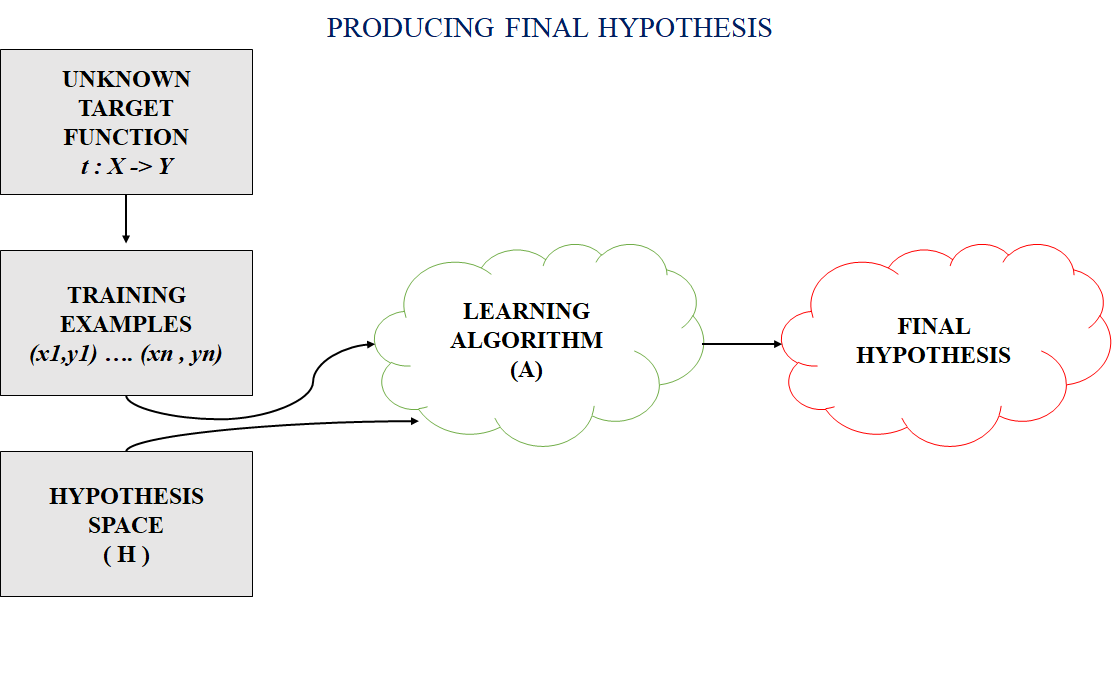
Hypothesis Space (H)
Hypothesis space is the set of all the possible legal hypothesis. This is the set from which the machine learning algorithm would determine the best possible (only one) which would best describe the target function or the outputs.
Hypothesis (h)
A hypothesis is a function that best describes the target in supervised machine learning. The hypothesis that an algorithm would come up depends upon the data and also depends upon the restrictions and bias that we have imposed on the data.
The Hypothesis can be calculated as:
- m = slope of the lines
- b = intercept
To better understand the Hypothesis Space and Hypothesis consider the following coordinate that shows the distribution of some data:
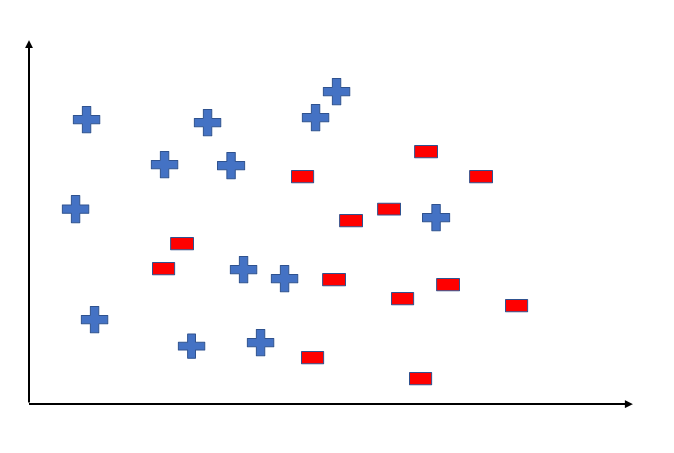
Say suppose we have test data for which we have to determine the outputs or results. The test data is as shown below:
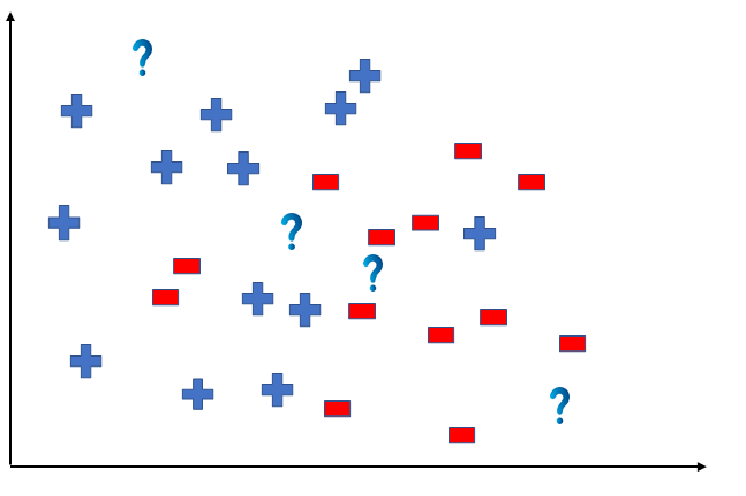
We can predict the outcomes by dividing the coordinate as shown below:
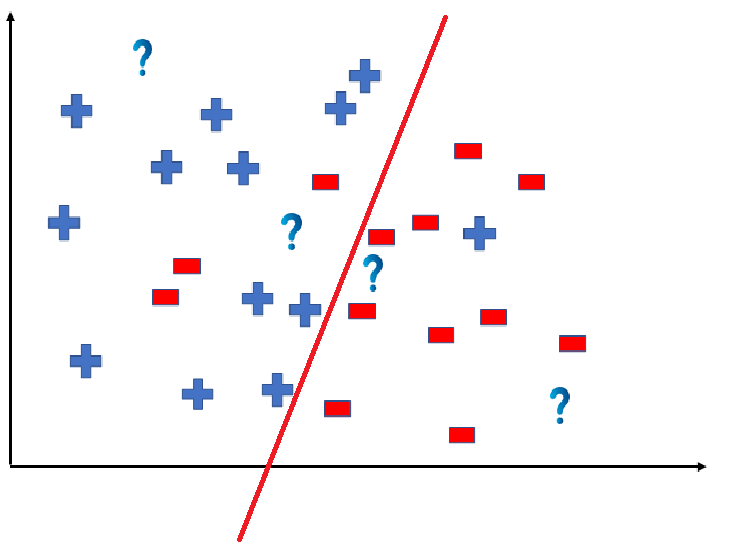
So the test data would yield the following result:
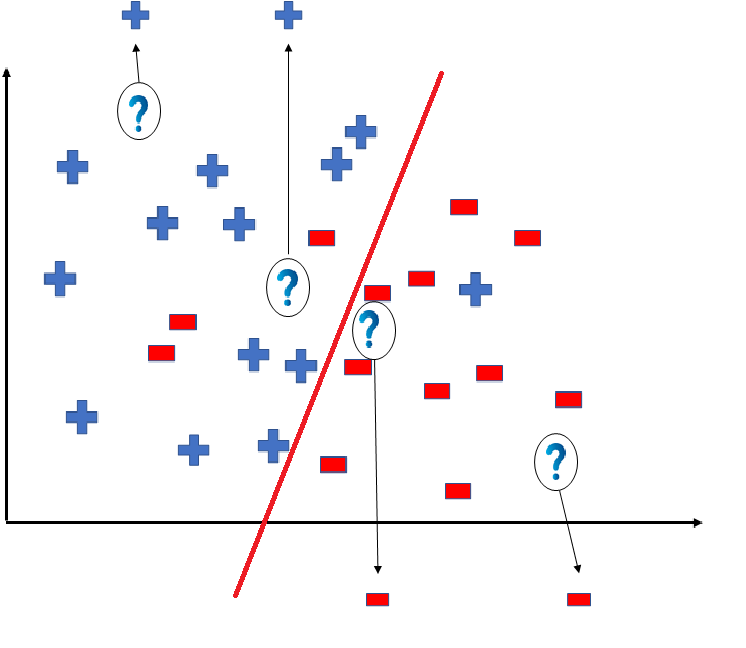
But note here that we could have divided the coordinate plane as:
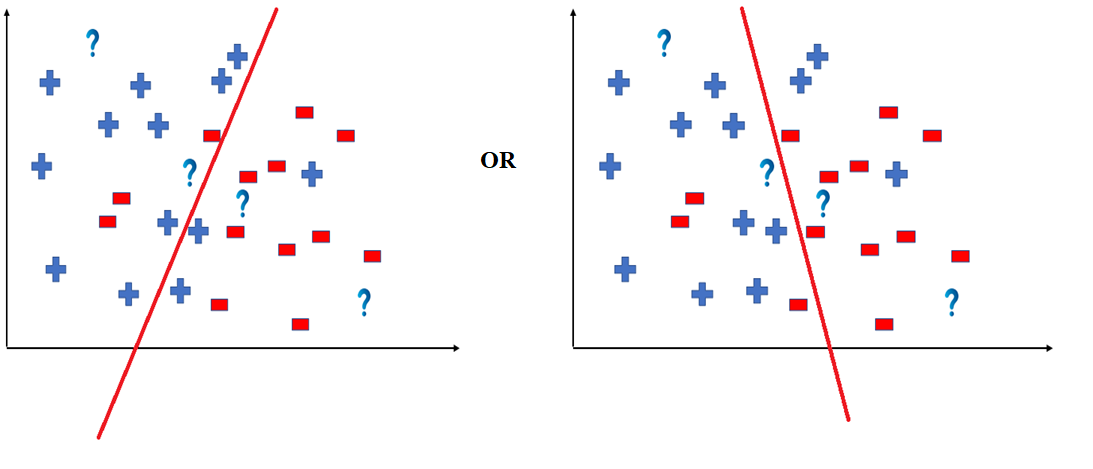
The way in which the coordinate would be divided depends on the data, algorithm and constraints.
- All these legal possible ways in which we can divide the coordinate plane to predict the outcome of the test data composes of the Hypothesis Space.
- Each individual possible way is known as the hypothesis.
Hence, in this example the hypothesis space would be like:
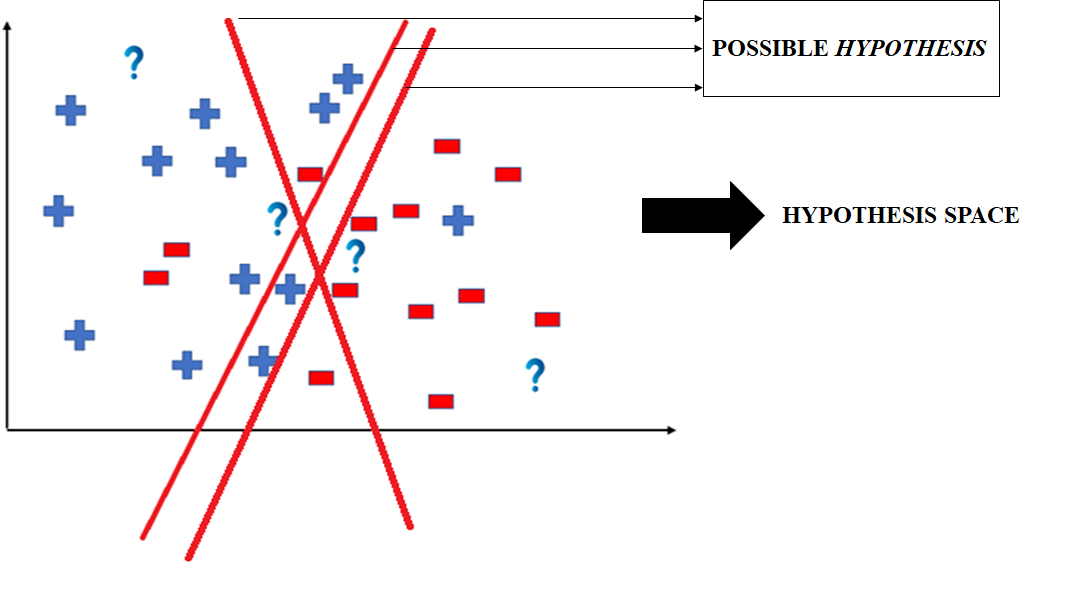
The hypothesis space comprises all possible legal hypotheses that a machine learning algorithm can consider. Hypotheses are formulated based on various algorithms and techniques, including linear regression, decision trees, and neural networks. These hypotheses capture the mapping function transforming input data into predictions.
Hypothesis Formulation and Representation in Machine Learning
Hypotheses in machine learning are formulated based on various algorithms and techniques, each with its representation. For example:
In the case of complex models like neural networks, the hypothesis may involve multiple layers of interconnected nodes, each performing a specific computation.
Hypothesis Evaluation:
The process of machine learning involves not only formulating hypotheses but also evaluating their performance. This evaluation is typically done using a loss function or an evaluation metric that quantifies the disparity between predicted outputs and ground truth labels. Common evaluation metrics include mean squared error (MSE), accuracy, precision, recall, F1-score, and others. By comparing the predictions of the hypothesis with the actual outcomes on a validation or test dataset, one can assess the effectiveness of the model.
Hypothesis Testing and Generalization:
Once a hypothesis is formulated and evaluated, the next step is to test its generalization capabilities. Generalization refers to the ability of a model to make accurate predictions on unseen data. A hypothesis that performs well on the training dataset but fails to generalize to new instances is said to suffer from overfitting. Conversely, a hypothesis that generalizes well to unseen data is deemed robust and reliable.
The process of hypothesis formulation, evaluation, testing, and generalization is often iterative in nature. It involves refining the hypothesis based on insights gained from model performance, feature importance, and domain knowledge. Techniques such as hyperparameter tuning, feature engineering, and model selection play a crucial role in this iterative refinement process.
In statistics , a hypothesis refers to a statement or assumption about a population parameter. It is a proposition or educated guess that helps guide statistical analyses. There are two types of hypotheses: the null hypothesis (H0) and the alternative hypothesis (H1 or Ha).
- Null Hypothesis(H 0 ): This hypothesis suggests that there is no significant difference or effect, and any observed results are due to chance. It often represents the status quo or a baseline assumption.
- Aternative Hypothesis(H 1 or H a ): This hypothesis contradicts the null hypothesis, proposing that there is a significant difference or effect in the population. It is what researchers aim to support with evidence.
Q. How does the training process use the hypothesis?
The learning algorithm uses the hypothesis as a guide to minimise the discrepancy between expected and actual outputs by adjusting its parameters during training.
Q. How is the hypothesis’s accuracy assessed?
Usually, a cost function that calculates the difference between expected and actual values is used to assess accuracy. Optimising the model to reduce this expense is the aim.
Q. What is Hypothesis testing?
Hypothesis testing is a statistical method for determining whether or not a hypothesis is correct. The hypothesis can be about two variables in a dataset, about an association between two groups, or about a situation.
Q. What distinguishes the null hypothesis from the alternative hypothesis in machine learning experiments?
The null hypothesis (H0) assumes no significant effect, while the alternative hypothesis (H1 or Ha) contradicts H0, suggesting a meaningful impact. Statistical testing is employed to decide between these hypotheses.

Similar Reads
- Hypothesis in Machine Learning The concept of a hypothesis is fundamental in Machine Learning and data science endeavours. In the realm of machine learning, a hypothesis serves as an initial assumption made by data scientists and ML professionals when attempting to address a problem. Machine learning involves conducting experimen 6 min read
- Demystifying Machine Learning Machine Learning". Now that's a word that packs a punch! Machine learning is hot stuff these days! And why won’t it be? Almost every "enticing" new development in the field of Computer Science and Software Development, in general, has something related to machine learning behind the veils. Microsoft 7 min read
- Machine Learning Examples In the modern era, Machine Learning (ML) has emerged as a cornerstone technology driving innovation and efficiency across various sectors. By harnessing algorithms that enable computers to learn from and make decisions based on data, ML is not just reshaping industries but also redefining our everyd 9 min read
- Decision Tree in Machine Learning A decision tree in machine learning is a versatile, interpretable algorithm used for predictive modelling. It structures decisions based on input data, making it suitable for both classification and regression tasks. This article delves into the components, terminologies, construction, and advantage 12 min read
- What is Machine Learning? "What is machine learning?" It's a question that opens the door to a new era of technology—one where computers can learn and improve on their own, much like humans. Imagine a world where computers don't just follow strict rules but can learn from data and experiences. This is the essence of machine 13 min read
- Best IDEs For Machine Learning Over the years, Machine Learning has made a significant impact in the market. As per a recent report, currently, the market is standing at USD 86.52 billion in 2024 and is expected to cross USD 598.92 billion by 2030 at a CAGR of 46% and above. This graph has marked the influential leap during the C 8 min read
- Learn Machine Learning in 45 Days Machine Learning has become one of the most demanding technologies in the world. It is well capable of automating tasks and too with intelligence (like a human touch). This process allows machines to automate tasks by delivering intelligence via machines. Machine Learning has drastically surged in t 7 min read
- How does Machine Learning Works? Machine Learning is a subset of Artificial Intelligence that uses datasets to gain insights from it and predict future values. It uses a systematic approach to achieve its goal going through various steps such as data collection, preprocessing, modeling, training, tuning, evaluation, visualization, 7 min read
- Machine Learning for Healthcare Machine Learning is a branch of Artificial Intelligence that helps computers learn and understand the data and recognize trends to make future predictions. ML uses algorithms that allow computers to identify patterns, make predictions, and derive insights from data, much like humans learn from exper 14 min read
- Ensuring Fairness in Machine Learning Algorithms Machine learning (ML) has become an integral part of various industries, influencing decisions in areas such as finance, healthcare, criminal justice, and more. However, the increasing reliance on ML algorithms has raised concerns about fairness and bias. Ensuring that these algorithms treat all gro 13 min read
- Applications of Machine Learning Machine learning is one of the most exciting technologies that one would have ever come across. As is evident from the name, it gives the computer that which makes it more similar to humans: The ability to learn. Machine learning is actively being used today, perhaps in many more places than one wou 5 min read
- Top Machine Learning Applications in 2019 Suppose you want to search for Machine Learning on Google. Well, the results you will see are carefully curated and ranked by Google using Machine Learning!!! That's how embedded ML is in the current technology. And this is only going to increase in the future. According to Forbes, the International 6 min read
- Random Forest Algorithm in Machine Learning Machine learning, a fascinating blend of computer science and statistics, has witnessed incredible progress, with one standout algorithm being the Random Forest. Random forests or Random Decision Trees is a collaborative team of decision trees that work together to provide a single output. Originati 15+ min read
- Continual Learning in Machine Learning As we know Machine Learning (ML) is a subfield of artificial intelligence that specializes in growing algorithms that learn from statistics and make predictions or choices without being explicitly programmed. It has revolutionized many industries by permitting computer systems to understand styles, 10 min read
- What is No-Code Machine Learning? As we know Machine learning is a field in which the data are provided according to the use case of the feature engineering then model selection, model training, and model deployment are done with programming languages like Python and R. For developing the model the person or developer must have the 10 min read
- Domain Knowledge in Machine Learning Domain Knowledge in machine learning refers to expertise and understanding of the specific field or subject matter to which the machine learning model is applied. While machine learning algorithms are powerful tools for analyzing data and making predictions, they often require domain experts to ensu 5 min read
- Why Machine Learning is The Future? Machine learning is a hot topic in the world of computer science. There are more than 4 lakh ML Engineers and the profession is becoming more popular as job seekers look for new skills to add to their portfolios. But what exactly is it? And how can you master this exciting field? Why is there a futu 7 min read
- How to Learn Machine Learning in 2024 Machine learning (ML) is a rapidly evolving field that combines computer science, statistics, and data analysis to enable computers to learn from data. As we step into 2024, the importance of ML continues to grow, making it a crucial skill for anyone looking to stay relevant in the tech industry. By 5 min read
- What is AutoML in Machine Learning? Automated Machine Learning (automl) addresses the challenge of democratizing machine learning by automating the complex model development process. With applications in various sectors, AutoML aims to make machine learning accessible to those lacking expertise. The article highlights the growing sign 13 min read
Improve your Coding Skills with Practice
What kind of Experience do you want to share?
Info Co Build
Introduction to machine learning.
Introduction to Machine Learning. Instructor: Prof. Sudeshna Sarkar, Department of Computer Science and Engineering, IIT Kharagpur. This course provides a concise introduction to the fundamental concepts in machine learning and popular machine learning algorithms. We will cover the standard and most popular supervised learning algorithms including linear regression, logistic regression, decision trees, k-nearest neighbour, an introduction to Bayesian learning and the naive Bayes algorithm, support vector machines and kernels and neural networks with an introduction to Deep Learning. We will also cover the basic clustering algorithms. Feature reduction methods will also be discussed. We will introduce the basics of computational learning theory. In the course we will discuss various issues related to the application of machine learning algorithms. We will discuss hypothesis space, overfitting, bias and variance, tradeoffs between representational power and learnability, evaluation strategies and cross-validation. The course will be accompanied by hands-on problem solving with programming in Python and some tutorial sessions. (from nptel.ac.in )
This lecture describes Hypothesis Space and Inductive Bias. Inductive learning has been explained. Notions of Restriction and Preference have also been introduced in the context of Inductive Bias. Finally the lecture introduces the concept of generalization of a learned model and its connection with overfitting and underfitting.
Go to the Course Home or watch other lectures:
Inductive Bias in Machine Learning
The phrase “inductive bias” refers to a collection of (explicit or implicit) assumptions made by a learning algorithm in order to conduct induction, or generalize a limited set of observations (training data) into a general model of the domain.
In this article, we’ll have a look at what is Inductive Bias, and how does it help the machine make better decisions.
Why Inductive Bias?
As seen in the previous article on Candidate-Elimination Algorithm, we get two hypotheses, one specific and one general at the end as a final solution.
Now, we also need to check if the hypothesis we got from the algorithm is actually correct or not, also make decisions like what training examples should the machine learn next.
Some of the fundamental questions for inductive reference are,
- What happens if the target concept isn’t in the hypothesis space?
- Is it possible to avoid this problem by adopting a hypothesis space that contains all potential hypotheses?
- What effect does the size of the hypothesis space have on the algorithm’s capacity to generalize to unseen instances?
- What effect does the size of the hypothesis space have on the number of training instances required?
Let’s have a look at what is Inductive and Deductive learning to understand more about Inductive Bias.
Inductive Learning:
This basically means learning from examples, learning on the go.
We are given input samples (x) and output samples (f(x)) in the context of inductive learning, and the objective is to estimate the function (f). The goal is to generalize from the samples and map such that the output may be estimated for fresh samples in the future.
In practice, estimating the function is nearly always too difficult, thus we seek extremely excellent estimates of the function.
The following are some instances of induction in practice:
Assessment of credit risk:
The x represents the customer’s properties.
Whether or whether the f(x) has been accepted for credit.
The diagnosis of disease:
The x represents the patient’s characteristics.
The f(x) is the illness they are afflicted with.
Face recognition: is a technique for recognizing someone’s face.
Bitmaps of people’s faces make up the x.
The f(x) is used to give the face a name.
Deductive Learning:
Learners are initially exposed to concepts and generalizations, followed by particular examples and exercises to aid learning.
Already existing rules are applied to the training examples.
Biased Hypothesis Space:
It does not include all types of training instances. The issue is that we have skewed the learner’s thinking to only evaluate conjunctive possibilities. In this instance, a more expressive hypothesis space is required.
Unbiased Hypothesis Space:
The obvious answer to the challenge of ensuring that the target idea is represented in hypothesis space H is to create a hypothesis space that can represent any teachable notion.

What is Inductive Bias?
As discussed in the introduction, Inductive bias refers to a set of assumptions made by a learning algorithm in order to conduct induction or generalize a limited set of observations (training data) into a general model of the domain.
Induction would be impossible without such a bias, because observations may generally be extended in a variety of ways.
Predictions for new scenarios could not be formed if all of these options were treated equally, that is, without any bias in the sense of a preference for certain forms of generalization (representing previous information about the target function to be learned).
The idea of inductive bias is to let the learner generalize beyond the observed training examples to deduce new examples.
‘ > ’ -> Inductively inferred from.
For example,
x > y means y is inductively deduced from x.
Types of Inductive Bias:
- Maximum conditional independence: It aims to maximize conditional independence if the hypothesis can be put in a Bayesian framework. The Naive Bayes classifier employs this bias.
- Minimum cross-validation error: Select the hypothesis with the lowest cross-validation error when deciding between hypotheses. Despite the fact that cross-validation appears to be bias-free, the “no free lunch” theorems prove that cross-validation is biased.
- Maximum margin: While creating a border between two classes, try to make the boundary as wide as possible. In support vector machines, this is the bias. The idea is that distinct classes are usually separated by large gaps.
- Minimum hypothesis description length: When constructing a hypothesis, try to keep the description as short as possible. Simpler theories are seen to be more likely to be correct. Occam’s razor does not suggest this. Simpler models are easier to test, not necessarily “more likely to be true.” See the principle of Occam’s Razor.
- Minimum features: features should be removed unless there is strong evidence that they are helpful. Feature selection methods are based on this premise.
- Nearest neighbors: Assume that the majority of the examples in a local neighborhood in feature space are from the same class.
If the class of a case is unknown, assume that it belongs to the same class as the majority of the people in its near vicinity. The k-nearest neighbor’s algorithm employs this bias. Cases that are close to each other are assumed to belong to the same class.

What is Inductive Bias in Machine Learning?
- February 22, 2024
- General , Supervised Learning
As I’m sure you know, Machine learning is the process by which a computer system can learn from past events to recognize patterns to predict the future.
With this comes some dense math and some exciting concepts.
In machine learning, there is this idea called inductive bias, which is the ability of your algorithm to generalize beyond the observed training examples to handle unseen data.
This guide will take you on a journey to explain the “why.” – why machines approach generalizability in this way and how you can use it in your algorithms to improve your predictions.
After reading this quick 3-minute guide, you’ll learn the following:
- What Inductive Bias is all about
- Why We Need Inductive Bias In Machine Learning
- A Quick Recap on Inductive Learning and Deductive Learning
- Overview of the Biased Hypothesis Space and the Unbiased Hypothesis Space
- And some terminology cleanup on Machine Learning Bias vs. Inductive Bias
Let’s do this!
What is Inductive Bias?
Inductive bias is simply the ability of your machine learning algorithms to generalize beyond the observed training examples to handle unseen data.
Why Do We Need Inductive Bias In Machine Learning?
In machine learning, to create our models, we build systems that can make assumptions about the world based on the data we give.
It wouldn’t be very helpful if we had a machine learning algorithm that could only make predictions on data it had already seen.
Think about it this way; if you wanted to predict fraud in real-time, and you could only predict fraud in situations you’ve seen before, you’d miss most new fraud cases.
What if the company has released a new store or a bank has released a new credit card that your algorithm hasn’t seen before?

Without an inductive bias, it would be impossible to learn from data because there would be no way to generalize.
Where did the Idea of Inductive Bias Come From?
At its core, machine learning is all about math.
After all, computers aren’t smarter than you or me; they just can process (do math) at highly efficient rates.
Inductive bias is part of the recipe that makes up the core of machine learning, which leverages some core ideas to achieve both practicality, accuracy, and computational efficiency.
While that sentence is a little weird, let me introduce you to 4 topics that will help me guide you through the path of fully understanding the role of inductive bias in machine learning.

What is Inductive Learning?
In everyday life, you often learn by example.
For instance, we might see someone else order food at a restaurant and then imitate their behavior when it’s our turn.
This type of learning is called inductive learning, a powerful way to quickly acquire new skills.
When we observe others, we can pick up on the important cues and “rules” that govern their behavior.
By imitating these examples, we learn the correct way to do things without explicitly being taught.
Inductive learning is instrumental when we encounter situations similar to those we’ve been in before, as we subconsciously apply our previous knowledge to the current scenario.
What is Deductive Learning
Deductive learning is a method of reasoning where you start with a general principle and then apply it to a specific situation.
This differs from inductive learning, where you’re deriving the rules yourself.
In deductive learning, the rules are already laid out, and now we apply them to our unique scenario.
For example, let’s say you want to learn how to bake a cake.
You open an old cookbook and find some recipes about baking all different types of cake.
You read all of these, go into your cabinet, and piece together some different recipes to make a wonderful cake.
In other words, deductive learning is a way of moving from general to specific.
It’s an efficient way to learn new information because it lets you focus on the task without getting bogged down in details.
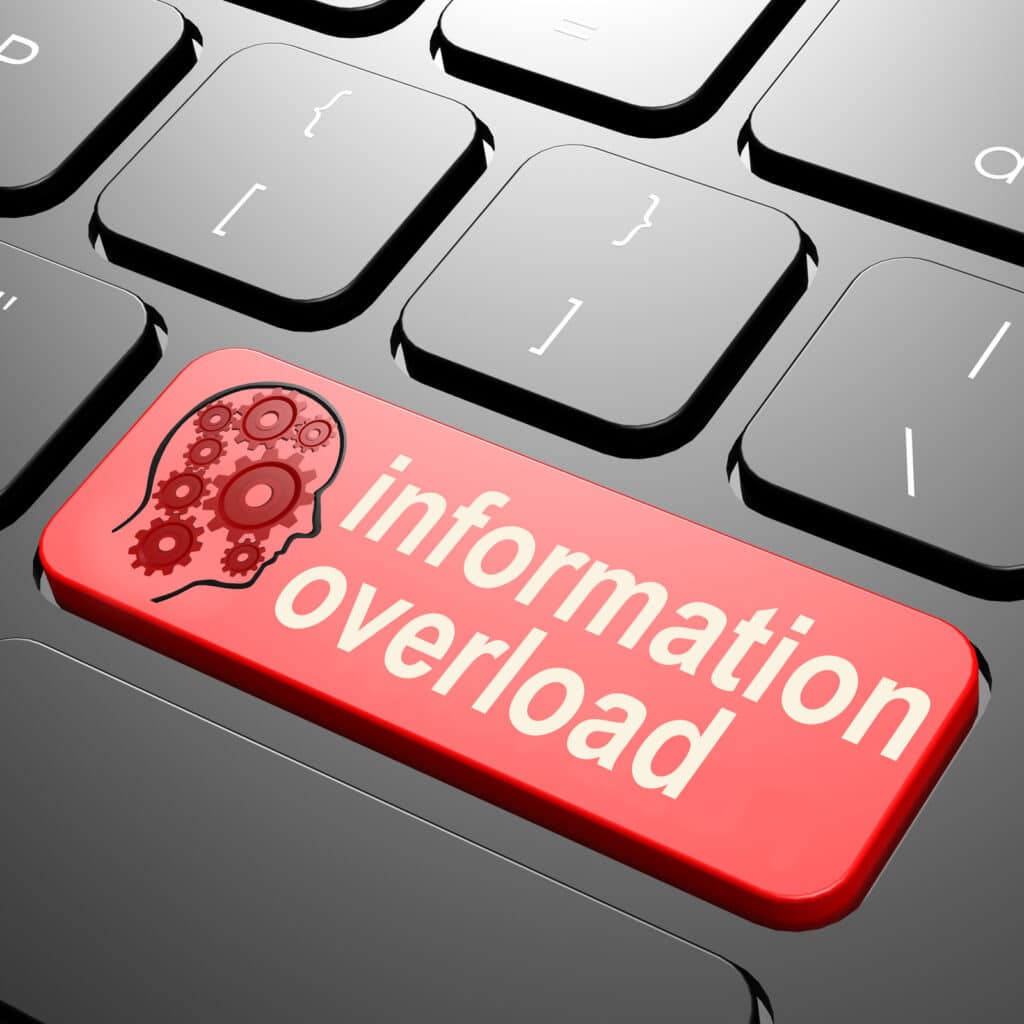
What is the Biased Hypothesis Space in Machine Learning?
The Biased Hypothesis space in machine learning is a biased subspace where your algorithm does not consider all training examples to make predictions.
This is easiest to see with an example.
Let’s say you have the following data:
Happy and Sunny and Stomach Full = True
Whenever your algorithm sees those three together in the biased hypothesis space, it’ll automatically default to true.
This means when your algorithm sees:
Sad and Sunny And Stomach Full = False
It’ll automatically default to False since it didn’t appear in our subspace.
This is a greedy approach, but it has some practical applications.

What is the Unbiased Hypothesis Space?
The unbiased hypothesis space is a space where all combinations are stored.
We can use re-use our example above:
This would start to breakdown as
Happy = True
Happy and Sunny = True
Happy and Stomach Full = True
Let’s say you have four options for each of the three choices.
This would mean our subspace would need 2^12 instances (4096) just for our little three-word problem.
This is practically impossible; the space would become huge.
So while it would be highly accurate, this has no scalability.

Bringing it all together, inductive bias in machine learning
Now that we know the difference between inductive and deductive learning and the positives and negatives of our hypothesis space, we can fully grasp what inductive bias is and how these all play a role in the core of machine learning.
As we said earlier, inductive bias is the ability of our algorithm to generalize beyond the observed training examples to infer new examples.
Since we do not have the “rules” already laid out (like in deductive learning), our algorithm has to create them (inductive learning).
Our algorithm can’t just depend on the training examples to make predictions (biased hypothesis space) since our accuracy would plummet on anything outside our space.
Our algorithm also can’t take every possible instance since we lack the scale and data access to make this feasible.
Our algorithm then has to generalize past the training examples, creating rules to apply to your predictions (inductive bias).
Other Quick Machine Learning Tutorials
At EML, we have a ton of cool data science tutorials that break things down so anyone can understand them.
Below we’ve listed a few that are similar to this guide:
- Instance-Based Learning in Machine Learning
- Generalization In Machine Learning
- Verbose in Machine Learning
- Zip Codes In Machine Learning
- get_dummies() in Machine Learning
- X and Y in Machine Learning
- Types of Data For Machine Learning
- Bootstrapping In Machine Learning
- F1 Score in Machine Learning
- Epoch In Machine Learning
- Recent Posts
- How to Make a Mashup Song Software [Top Tips Inside] - December 23, 2024
- Optimizing Neural Network for Regression [Boost Accuracy with Expert Tips] - December 23, 2024
- How much does a software engineer make at Gecko Robotics? [Top Salary Negotiation Tips] - December 22, 2024
- Privacy Policy
- Free Courses
New Technology
Trending Technology Machine Learning, Artificial Intelligent, Block Chain, IoT, DevOps, Data Science
- Machine Learning
- _TensorFlow
- Artificial Intelligence
- Deep Learning
- Data Science
- Block Chain
Recent Post
Search This Blog
Hypothesis space and inductive bias | inductive bias | inductive learning | underfitting and overfitting.

No comments:
Post a comment, popular articles.
- Conflict Resolution in AI We have two rules, Rule 2 and Rule 3, with the same IF part. Thus both of them can be set to fire when the condition part is satisfied.T...

- Artificial Intelligence - Question and Answer Define intelligence. Intelligence is a rather hard to define term. Intelligence is often defined in terms of what we ...

- Developers Setup (Tools)

Free Data Science PDF Books
Top 10 Python Data Science book 🧵: — Python Coding (@clcoding) July 9, 2023
- Follow on Twitter
- Like on Facebook
- Subscribe on Youtube
- Follow on Instagram
Popular Posts

Top 5 books for deep learning beginners
Top 5 books for deep learning beginners 🧵: — Python Coding (@clcoding) December 4, 2022

- Machine Learning using Python
- Python and Statistics for Financial Analysis
- Artificial Intelligence (AI) using Python
- Data Science using Python
- Automation with Python
Free Artificial intelligence Books
Free Artificial intelligence Books 🧵: — Python Coding (@clcoding) November 18, 2022
Previous Topic
- ► September (1)
- ► August (3)
- ► July (6)
- ► June (29)
- ► May (7)
- ► March (32)
- ► February (1)
- ► November (3)
- ► October (6)
- ► June (1)
- ► December (1)
- ► March (1)
- ► January (3)
- ► October (3)
- ► September (5)
- ► June (4)
- ► May (18)
- ► April (4)
- ► March (6)
- ► February (5)
- ► January (5)
- ► December (6)
- ► August (1)
- ► May (3)
- ► November (2)
- ► October (1)
- ► September (6)
- ► July (4)
- ► June (14)
- ► May (49)
- ► April (95)
- ► March (146)
- ► February (6)
- ► December (18)
- ► November (6)
- ► October (21)
- ► September (27)
- ► August (16)
- ► July (30)
- Breadth-first Search (BFS) in AI
- Types of Search Algorithms in AI
- Overfitting in Machine Learning | Underfitting and...
- Learning Decision Tree in Machine Learning
- Goal and Search of Artificial Intelligence
- What is Search in Artificial Intelligence ?
- Problem Solving Agent in Artificial Intelligence
- Random Variables and Probability Distribution
- Measures of Central Tendency and Dispersion | Skew...
- Introduction of Data Analyst | What is Data analys...
- Data and Statistics in Data Science
- Fundamentals of Neural Networks: Architectures, Al...
- Decision Tree in Machine Learning | Decision Nodes...
- Agent types in Artificial Intelligence | Simple Re...
- Environments in Artificial Intelligence | Properti...
- Linear Regression in Machine Learning | Types of R...
- Evaluation and Cross-Validation
- Hypothesis Space and Inductive Bias | Inductive Bi...
- PEAS in Artificial Intelligence
- What is Intelligent Agent ? | Agent Definition | A...
- ► April (9)
- automation (2)
- Big Data (6)
- Block Chain (86)
- cloud computing (7)
- coursera (41)
- Data Analytics (43)
- Data Camp (5)
- Data Mining (13)
- Data Science (33)
- Deep learning (33)
- DevOps (79)
- Machine Learning (159)
- ML Books (15)
- Tech News (78)
- TensorFlow (8)
- Tnsorflow (6)
- Web Development (5)
Related Topic

Free Machine Learning pdf Books
Free Machine Learning pdf Books 🧵: — Python Coding (@clcoding) November 3, 2022


IMAGES
COMMENTS
Jun 25, 2024 · The inductive bias of an algorithm influences how it selects a hypothesis (a possible explanation or model) from the hypothesis space (the set of all possible hypotheses) that best fits the training data.
Apr 25, 2024 · All these legal possible ways in which we can divide the coordinate plane to predict the outcome of the test data composes of the Hypothesis Space. Each individual possible way is known as the hypothesis. Hence, in this example the hypothesis space would be like: Hypothesis Space and Representation in Machine Learning
Mar 28, 2020 · This type of problems (learnings) is called inductive learning problems because we identify a function by inducting on data. Hypothesis space is a set of valid hypothesis, i.e. all possible functions.
This lecture describes Hypothesis Space and Inductive Bias. Inductive learning has been explained. Notions of Restriction and Preference have also been introduced in the context of Inductive Bias. Finally the lecture introduces the concept of generalization of a learned model and its connection with overfitting and underfitting.
Learn what inductive bias is and how it affects the generalization of learning algorithms. Explore different types of inductive bias and their examples, such as maximum margin, minimum cross-validation error, and nearest neighbors.
Hypothesis space (H) is the composition of all legal best possible ways to divide the coordinate plane so that it best maps input to proper output. Further, each individual best possible way is called a hypothesis (h). Hence, the hypothesis and hypothesis space would be like this: Hypothesis in Statistics
Feb 22, 2024 · Bringing it all together, inductive bias in machine learning. Now that we know the difference between inductive and deductive learning and the positives and negatives of our hypothesis space, we can fully grasp what inductive bias is and how these all play a role in the core of machine learning.
Output : A hypothesis h ⊆ H Inductive Bias Need to make assumptions - Experience alone doesn't allow us to make conclusion about unseen data instances Two types of bias : - Restriction : Limit the hypothesis space - Preference : Impose ordering on hypothesis space Inductive learning Inductive Learning : Inducing a general function from ...
Jun 13, 2022 · The prioritization of some hypotheses (restriction of hypothesis space) is an inductive bias. So the model is biased toward some group of hypotheses. For the previous example, one can choose a linear model based on some prior knowledge about data and thus prioritize linear generalization.
Hypothesis space is the set of all hypotheses that a machine learning system can produce. It is de ned by a hypothesis language and a language bias, which re ect the inductive bias of the learner.